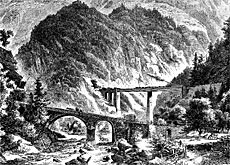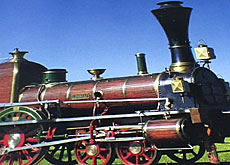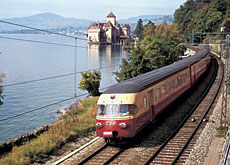Swiss railways faced an uphill struggle

Switzerland’s railways are today held up as a model of efficiency, with one of the most extensive networks in Europe and trains running like clockwork.
But they were slow to work up a head of steam, and when the first line came into service in 1847, it was already 20 years behind the times.
The 23.3-kilometre track linking Zurich to Baden was small compared with those already stretching across the rest of the continent.
But if Switzerland was slow off the mark, it was because politics and geography put the brakes on progress.
“You have to remember that in the first half of the 19th century, Switzerland was nothing more that a loose alliance of states,” said Kilian Elsasser, director of Lucerne’s transport museum.
“The cantons oversaw early railway development, and they were too small to consider projects like a line between Geneva and Zurich.”
Tough landscape
Switzerland’s mountainous landscape also hampered development of the railways, which meant the first train services appeared only around major towns and cities.
But the enthusiasm for railways overcame these difficulties by the middle of the century. In a few decades, with the help of German, French and Italian investors, Switzerland had caught up with its neighbours.
The Gotthard line was opened in 1882, putting Basel just ten hours away from Chiasso, on the Italian border.
People from all over Europe came to admire the project with its soaring bridges and its 15-kilometre tunnel, and it was even compared at the time to the Suez Canal.
What visitors tended to overlook was the living hell the construction workers, who were mostly Italian, went through. At least 199 of them gave their lives for the Gotthard.
National railways
Nothing, however, could stand in the way of progress. A large majority of Swiss citizens voted in 1898 to nationalise most of the rail network, owned at the time by five major and 26 smaller companies.
“Most companies were losing money, and investors weren’t interested in putting funds into railway projects,” Elsasser told swissinfo.
“On the other hand, the federal state, which had become much stronger, realised that it had an obligation to ensure the survival of the rail network.”
Like many historians, Elsasser believes that the price – over SFr1 billion – was too much.
“It was important at the time, though, to buy everything in one single purchase,” he added.
“The Swiss government didn’t like the idea that foreign shareholders could possibly control the railway network.”
The Swiss Federal Railways inherited rundown tracks and rolling stock, and had to invest massively during the first decades of the 20th century to upgrade its facilities and electrify its network.
swissinfo, Marc-André Miserez

In compliance with the JTI standards
More: SWI swissinfo.ch certified by the Journalism Trust Initiative



You can find an overview of ongoing debates with our journalists here . Please join us!
If you want to start a conversation about a topic raised in this article or want to report factual errors, email us at english@swissinfo.ch.